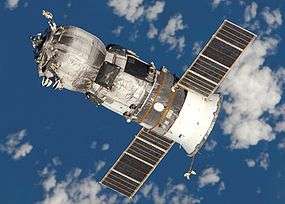Comparison of space station cargo vehicles
A number of different spacecraft have been used to carry cargo to and from space stations.
Legend for below table: [under development] — [retired,canceled] — [operational,inactive]
| Spacecraft | Origin | Manufacturer | Launch system | Length (m) | Dry mass (kg) | Launch mass (kg) | Payload (kg) | Payload volume (m³) | Return payload (kg) | Diameter (m) | Generated power (W) | Automated Docking | Status |
|---|---|---|---|---|---|---|---|---|---|---|---|---|---|
| Progress 7K-TG | Energia | Soyuz-U | None | No | Retired | ||||||||
| Progress-M 11F615A55 |
Energia | Soyuz-U Soyuz-U2 |
7.2 | 7,130 | 2,600 | 7.6 | 150 with optional Raduga capsule | 2.72 | 600[1] | Yes | Retired | ||
| Progress-M1 |
Energia | Soyuz-U Soyuz-FG |
None | Yes | Retired | ||||||||
| Progress-M 11F615A60 |
Energia | Soyuz-U Soyuz-2.1a |
7.2 | 7,150 | 2,230 | 7.6 | None | 2.72 | 700 | Yes | Retired | ||
| Progress-MS | Energia | Soyuz-U Soyuz-2.1a |
7.2 | 7,150 | 2,230 | Yes | Operational[2] | ||||||
| TKS | TsKBM | Proton-K | 17.51 | 13,688 | 21,620 | 12,600 | 4.15 | 2,400 | No | Retired | |||
| ATV | EADS | Ariane 5ES | 10.3 | 10,470[3] | 20,750[3] | 7,667[3] | 48 (pressurized) | None | 4.5 | 3,800[4] | Yes | Retired | |
| HTV | JAXA | H-IIB | 10 | 10,500[5] | 16,500[5] | 3,000 pressurized, 1,000 unpressurized[5] | 14 (pressurized), plus 16 (unpressurized)[5] | 20 with optional capsule[6] | 4.4 | 200 | No | Operational | |
| HTV-X | JAXA | H3 Launch Vehicle[7] | 10 with cargo module, 6.2 without | 8,300 | 15,500 total[8] | 4,069 pressurized, optional 1,750 unpressurized | 78 total | 4.4 | 1,000 | No, Technology trial of an automated IDSS docking port fitted in place of unpressurised cargo module being planned | Development | ||
| Dragon | SpaceX | Falcon 9 | 6.1 | 4,200[9] | 10,200 | 3,310 pressurized or unpressurized, in any mixture[10] | 10.0 (pressurized), plus 14 (unpressurized), or 34 (unpressurized with extended trunk)[11] | 2,500 capsule return[12] | 3.7 | 2,000[13] | No | Operational | |
| Dragon 2 cargo | SpaceX | Falcon 9 | 8.1 | 6,400 | 3,310 | 10.0 (pressurized), plus 14 (unpressurized) | 2,500 | 3.7 | Yes | Development | |||
| Cygnus (standard) | Orbital | Antares 1x0 | 5.14 | 1,500[14] | 2,000[14] | 18.9[14] | None | 3.07 | 3,500[15] | No | Retired | ||
| Cygnus (enhanced) | Orbital ATK | Antares 230 Atlas V 401 |
6.34 | 1,800[16] | 3,500[16] | 27[16] | None | 3.07 | No | Operational | |||
| Tianzhou | CAST | Long March 7 | 9 | 13,500 | 6,500 includes 2,000 propellant | 3.35 | Yes | Operational | |||||
| Dream Chaser Cargo System | Sierra Nevada Corporation | Atlas V Vulcan[17] |
5,000 pressurized, 500 unpressurized[18] | 1,750[18] | Yes | Development |

See also
References
- ↑ "Progress M". Archived from the original on 3 August 2009. Retrieved 29 May 2012.
- ↑ "Upgraded Progress MS docks with the ISS". NASASpaceflight.com. 23 December 2015. Retrieved 26 December 2015.
- 1 2 3 "ESA Automated Transfer Vehicle". ESA. Retrieved 7 August 2013.
- ↑ "ATV Utilization Relevant Data" (PDF). Retrieved 29 May 2012.
- 1 2 3 4 "JAXA transition examination of the new space station supply machine (HTV-X)" (PDF). JAXA. Retrieved 6 February 2018.
- ↑ "HTV 搭載小型回収カプセルの開発" (PDF) (in Japanese). Japan Aerospace Exploration Agency. 12 November 2014. Retrieved 2016-10-21.
- ↑ "H3,H‐IIA/Bのミッション割当て(案)" (PDF) (in Japanese). MEXT. 8 March 2016. Retrieved 2016-03-10.
- ↑ http://www.jaxa.jp/press/2017/12/files/20171206_HTV-X.pdf
- ↑ "SpaceX Brochure v7" (PDF). Archived from the original (PDF) on 20 March 2012. Retrieved 29 May 2012.
- ↑ Bergin, Chris (19 October 2012). "Dragon enjoying ISS stay, despite minor issues – Falcon 9 investigation begins". NASASpaceflight.com. Retrieved 21 October 2012.
CRS-2 will debut the use of Dragon’s Trunk section, capable of delivering unpressurized cargo, prior to the payload being removed by the ISS’ robotic assets after berthing.
- ↑ http://www.spacex.com/sites/spacex/files/pdf/DragonLabFactSheet.pdf
- ↑ http://www.nasaspaceflight.com/2012/10/falcon-9loft-dragon-crs-1-mission-iss-attempt1/
- ↑ "Dragonlab Datasheet" (PDF). Archived from the original (PDF) on 4 January 2011. Retrieved 29 May 2012.
- 1 2 3 "Cygnus Fast Sheet" (PDF). Orbital Sciences Co. Retrieved 7 August 2013.
- ↑ "The Annual Compendium of Commercial Space Transportation: 2012" (PDF). Federal Aviation Administration. February 2012. Retrieved 8 February 2013.
- 1 2 3 "Cygnus Spacecraft Information". Spaceflight101.
- ↑ "NSRC Day 2 Summary". Parabolic Arc. Retrieved 6 June 2016.
- 1 2 "Sierra Nevada Hopes Dream Chaser Finds "Sweet Spot" of ISS Cargo Competition". SpaceNews. Retrieved 20 February 2016.
This article is issued from
Wikipedia.
The text is licensed under Creative Commons - Attribution - Sharealike.
Additional terms may apply for the media files.
